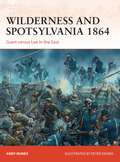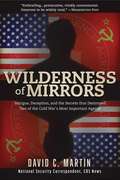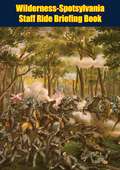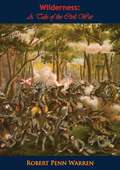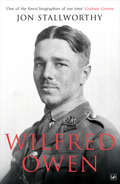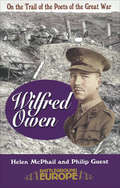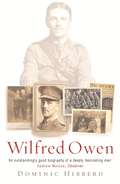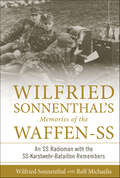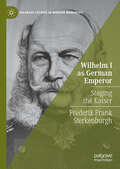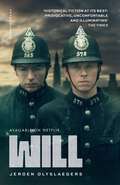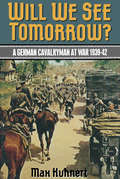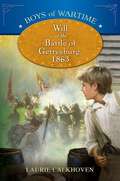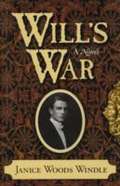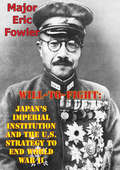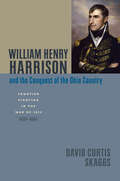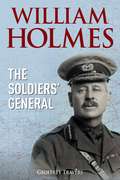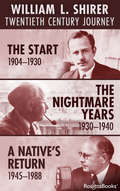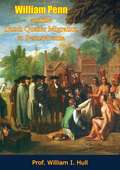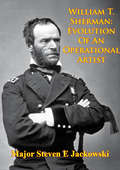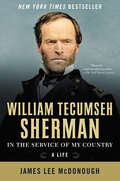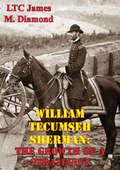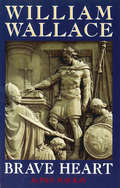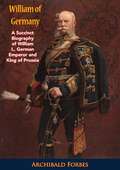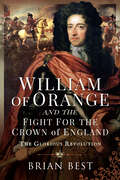- Table View
- List View
Wilderness and Spotsylvania 1864
by Peter Dennis Andy NunezGrant and Lee fought near Chancellorsville, VA in a confusing series of battles amidst brush thickets and wildfires. Unlike previous campaigns, Grant simply kept flanking Lee, trying frontal assaults at Spotslvania's 'mule-shoe' and Cold Harbor along the way to laying seige to Richmond and Petersburg. In May 1864 the Union Army of the Potomac under General George Meade had been in a leisurely pursuit of the Confederate Army of Northern Virginia for nearly a year after the defeat of the Rebels at Gettysburg. Confederate commander General Robert E. Lee still retained his awe-inspiring reputation for wrecking Union armies that got too close to Richmond and Meade was still cautious. His tactics at Gettysburg were defensive and he was unsure that he was able to take the offensive against Lee. However, things changed when President Abraham Lincoln appointed General Ulysses S. Grant to command all Union armies. Grant came east and laid out a comprehensive strategy for the rest of the war.In the deep South, General William T. Sherman would march out of Tennessee to cut the Confederacy in half by taking Atlanta. Grant would lead the Army of the Potomac across the Rapidan River and march on Richmond. He had the manpower and equipment to accomplish his objective, easily outnumbering Lee. Lee, on the other hand, was far from beaten and saw Grant as just another Union general to be sent packing, much as he had sent McClellan, Burnside, Pope and Hooker away two years before. As Grant's army slowly entered the tangle of woods beyond Fredericksburg known as the Wilderness, Lee planned to pin him there and destroy him as he struggled to emerge. The stage was set for the campaign that would forever dictate the terms of the Civil War in the East.
Wilderness of Mirrors: Intrigue, Deception, and the Secrets that Destroyed Two of the Cold War's Most Important Agents (Espionage/intelligence Library)
by David MartinAt the dawn of the Cold War, the world’s most important intelligence agencies—the Soviet KGB, the American CIA, and the British MI6—appeared to have clear-cut roles and a sense of rising importance in their respective countries. But when Kim Philby, head of MI6’s Russian division and arguably the twenty-first century’s greatest spy, was revealed to be a Russian mole along with British government heavyweights Donald Maclean and Guy Burgess, everything in the Western intelligence world turned upside down. Here is the true story of how the American James Bond—the colorful, foulmouthed, pistol-packing, alcoholic ex-FBI agent William “King” Harvey—put the finger on Philby; how James Jesus Angleton, the chain-smoking poet of Yale University and the CIA’s supposed “master spy” in charge of counterintelligence, began his descent into a paranoid wilderness of mirrors upon learning of family friend Kim Philby’s ultimate betrayal; and the devastating consequences of the loss of MI6 prestige and the CIA’s subsequent self-defeating witch hunts. Every revelation, every stranger-than-fiction twist and turn is all the more intriguing as truths become lies and unlikely scenarios are revealed as reality. With impeccable sourcing and the use of thousands of pages of declassified research, David C. Martin’s Wilderness of Mirrors is widely recognized as a masterpiece of intelligence literature.
Wilderness-Spotsylvania Staff Ride Briefing Book [Illustrated Edition]
by AnonThe Battle of the Wilderness began Lt. Gen Ulysses S. Grant’s 1864 Overland Campaign against the Confederate army of Northern Virginia that ultimately, after many weeks and horrendous casualties, forced Gen. Robert E. Lee’s men back to the defenses at Richmond. The fighting took place in an area of Virginia where tangled underbrush and trees had grown up in long-abandoned farmland, near the old Chancellorsville battlefield. Close-quarters fighting among the dense woods created high casualties, but the battle proved inconclusive for both sides. It produced an important strategic event, however; whereas before Union commanders had withdrawn their armies after failing to achieve victory south of the Rappahannock River, Grant did not retreat. Instead, he attempted to outflank Lee by moving to the left, setting the stage for the Battle of Spotsylvania Courthouse.In this briefing book the battle and its environs are discussed and described in detail.
Wilderness: A Tale Of The Civil War
by Robert Penn WarrenIn the summer of 1863, Adam Rosenzweig has left a Bavarian ghetto and sailed for America to join the Union Army. Fired by the revolutionary idealism of mid-nineteenth-century Europe, he hopes to aid a cause which he believes to be as simple as he knows it to be just. But thwarted by the discovery of a physical deformity which he had hoped to conceal, he must try other means to find his "truth."
Wilfred Owen
by Jon StallworthyOf all the poets of the First World War, Wilfred Owen most fires the imagination today – this is the comprehensive literary biography of the greatest WW1 poetWilfred Owen tragically died in battle just a few days before the Armistice. Now, during the centenary year of his death, this biography honours Owen’s brief yet remarkable life, and the enduring legacy he left. Stallworthy covers his life from the childhood spent in the backstreets of Shrewsbury to the appalling final months in the trenches. More than a simple account of his life, it is also a poet's enquiry into the workings of a poet's mind. This revised edition contains the beautiful illustrations of the original edition, including the drawings by Owen and facsimile manuscripts of his greatest poems, as well as a new preface by the author.‘One of the finest biographies of our time.’ Graham Greene‘An outstanding book, a worthy memorial to its subject.’ Kingsley Amis ‘As lovingly detailed as the records of Owen's short life permit, but it is always fascinatingly readable, in fact engrossing.’ Sunday Telegraph
Wilfred Owen: On the Trail of the Poets of the Great War (Battleground Europe)
by Helen McPhail Philip GuestThis is a guide to the battlefields that inspired the young and sensitive poet, whose poems are probably the twentieth century's best-known literary expressions of experience of war. Detailed maps, military diaries, photographs and modern roads guide the visitor through the battlefields. Owen's letters are used extensively, together with his poetry, linking specific places events, vividly describing the suffering of the trench.
Wilfred Owen: The definitive biography of the best-loved war poet
by Dominic HibberdThe definitive biography of the war poet - 'Dominic Hibberd has probably done more more than any other individual to illuminate Owen's life and work. His new Life is a triumph ... it is difficult to believe it will ever be superseded' Mark Bostridge, The Independent on SundayWhen Wilfred Owen died in 1918 aged 25, only five of his poems had been published. Yet he became one of the most popular poets of the 20th century. For decades his public image was controlled by family and friends, especially his brother Harold who was terrified anyone might think Wilfred was gay. In recent years much new material has become available. This book, based on over thirty years of wide-ranging research, brings new information to almost every part of Owen's life. Owen emerges as a complex, fascinating and often endearing character with an intense delight in being alive.
Wilfred Owen: The definitive biography of the best-loved war poet
by Dominic HibberdThe definitive biography of the war poet - 'Dominic Hibberd has probably done more more than any other individual to illuminate Owen's life and work. His new Life is a triumph ... it is difficult to believe it will ever be superseded' Mark Bostridge, The Independent on SundayWhen Wilfred Owen died in 1918 aged 25, only five of his poems had been published. Yet he became one of the most popular poets of the 20th century. For decades his public image was controlled by family and friends, especially his brother Harold who was terrified anyone might think Wilfred was gay. In recent years much new material has become available. This book, based on over thirty years of wide-ranging research, brings new information to almost every part of Owen's life. Owen emerges as a complex, fascinating and often endearing character with an intense delight in being alive.
Wilfried Sonnenthal's Memories of the Waffen-SS: An SS Radioman with the SS-Karstwehr-Bataillon Remembers
by Rolf Michaelis Wilfried SonnenthalA firsthand account of a Waffen-SS radio operator
Wilhelm I as German Emperor: Staging the Kaiser (Palgrave Studies in Modern Monarchy)
by Frederik Frank SterkenburghThis book offers the first-ever scholarly study of Wilhelm I as Germany’s first Kaiser. For decades, Wilhelm has been dismissed by historians as a political nullity and an unwilling imperial figurehead, who was perpetually overruled by chancellor Otto von Bismarck. As a result, scholars concluded that the imperial role did not reach maturity until the accession of Wilhelm II. This book challenges this assumption by analysing how Wilhelm used self-staging to effectuate his role as German emperor and set the precedent for his successors, Friedrich III and Wilhelm II. It explores how he oversaw and intervened in the political and military decision-making processes, his use of politics of history, his understanding and practicing of the imperial role towards other German states and dynasties, his self-presentation in the new German capital, and how his public persona was distorted in German cultural memory after his death in 1888. The book draws on a wealth of previously unexplored sources, including material from Wilhelm’s personal archive, the archives of the Hohenzollern monarchy, the Prussian state, and local archives. It offers a much-needed reassessment of Wilhelm I and makes an important contribution to debates on the role of the Kaiser in German politics, the political system, and culture of the early German nation state, and how the Hohenzollern monarchy adapted to the demands of generating popular support for its new German imperial role.
Will
by Jeroen OlyslaegersA tense, thrilling, morally murky read, set in Nazi-occupied Antwerp and inspired by the author's own family history of collaboration during WWIIIt is 1941, and Antwerp is in the grip of Nazi occupation. Young policeman Wilfried Wils has no intention of being a hero - but war has a way of catching up with people. When his idealistic best friend draws him into the growing resistance movement, and an SS commander tries to force him into collaborating, Wilfried's loyalties become horribly, fatally torn. As the beatings, destruction and round-ups intensify across the city, he is forced into an act that will have consequences he could never have imagined. Will asks what any of us would risk to fight evil.
Will We See Tomorrow?: A German Cavalryman at War, 1939–1942
by Max KuhnertThis memoir of a Nazi cavalryman offers a rare glimpse at the frontlines of WWII—in Poland, France, and Russia—from the perspective of a German soldier. Throughout the Second World War, the German Army was regarded as the most organized and technologically advanced fighting force in the world. And yet, while much is written about its Luftwaffe and Panzer tanks, the German military was mostly horse-drawn. The memoir of German mounted cavalryman Max Kuhnert takes readers inside this vital yet often overlooked aspect of the conflict. Originally from Dresden, Kuhnert enlisted in the German Army in 1939, and was posted to a cavalry unit which would go on to provide mounted reconnaissance troops for infantry regiments. His account tells of mobilization, time spent in occupied Denmark, and the invasions of Poland, France, and Russia. He also recounts the retreat from Russia, as well as his return to Germany after being wounded
Will at the Battle of Gettysburg, 1863
by Laurie CalkhovenTwelve-year-old Will wants to be a drummer in the Union army, but he's stuck far from the fighting in his sleepy hometown of Gettysburg, Pennsylvania. Then the Union and Confederate armies converge on Gettysburg, and suddenly Will and his family are caught up in the battle. From delivering important messages and helping the wounded to even saving a young soldier's life, Will takes readers on a firsthand trip through one of the Civil War's most significant battles.
Will's War: A Novel
by Janice Woods WindleWhen Janice Woods Windle uncovered nearly 3,000 pages of original transcripts from the landmark 1917 treason trial of her grandfather Will Bergfeld, she knew she’d struck literary gold. Accused by the federal government of plotting to assassinate President Woodrow Wilson, Bergfeld became a national figure, and his trial became the Aaron Burr case of its day, exposing the anti-German sentiment that occupied much of this country during World War I. From those transcripts, and from her own family lore, this best-selling author of True Women and Hill Country has written another unforgettable historical novel. Will’s War is the compelling saga of Will Bergfeld and his fight for freedom-and of the three strong women who loved him and made sacrifices on his behalf. Will Bergfeld is a brash, high-spirited young man born and raised in Seguin (pronounced Sea-geen), one of Texas’s oldest German-settled towns. After moving west to Weinert, a new immigrant community, Will becomes a rural mail carrier. He is also a devoted advocate of workers’ and farmers’ rights at a time when robber barons such as Vanderbilt and Rockefeller trampled freely on the little man. As American involvement in the war in Europe became inevitable, its citizens back home turn a suspicious eye to anyone potentially involved in the conflict: This included anybody with a German surname or anybody supposedly involved in government activities. It is no wonder that the outspoken Will Bergfeld soon became a prime suspect. The story of Will’s trial is largely told through the eyes of the women who love him: his wife Virginia, his mother-in-law Bettie King, and his sister Louise. (Readers of Windle’s previous novels will recognize a few of these beloved characters.) Also in the mix are Anna Bennett, the lonely woman Will once jilted whose anger threatens to send him to his death; Bill Atwell, Will’s dapper defense attorney who must match wits with a formidable foe to make sure justice is done; and Tom Grimes, the brooding Texas Ranger whose conscience may help save Will’s life. Will Bergfeld becomes the scapegoat in a vicious witch-hunt spurred on by the same fear and misplaced patriotism that would later give rise to the Japanese internment camps of World War II and the McCarthy congressional hearings of the 1950s. Janice Woods Windle has effortlessly woven pages from the actual trial transcripts into her novel to create a courtroom drama full of false testimony, evidence tampering and governmental wrongdoing-made all the more remarkable since it is based on fact.
Will-To-Fight: Japan’s Imperial Institution And The U.S. Strategy To End World War II
by Major Eric S. FowlerSun Tzu asserts that success is not winning every battle fought, but subduing the enemy's will without fighting. Nevertheless, modern military thought fails to distinguish an enemy's will-to-fight from their means to do so, limiting the ways military leaders apply operational art, problem framing, and conflict termination in pursuit of strategic objectives. The author asserts that gaining and maintaining a position of relative advantage for favorable conflict resolution requires leaders to understand the enemy's will-to-fight with equal fidelity as their means. This study examines U.S. planning efforts for post-WWII Japan from 1942 to 1945, focusing on the options planners possessed to achieve their ends; their choice to safeguard the Japanese Emperor; their understanding of the Japanese will-to-fight; and the way planners developed that understanding. The record reveals that-despite more forceful options-planners favored safeguarding the Imperial Institution; planners considered the Japanese people's will-to-fight as inexorably linked to the condition of their Sovereign, increasing in response to threats against Japanese national identity; and planners developed this understanding through discourse among experts in diplomacy, military governance, political culture, anthropology, and military intelligence. The implication-an enemy's will-to-fight can be targeted separate from their means and doing so may not require fighting.
William Henry Harrison and the Conquest of the Ohio Country: Frontier Fighting in the War of 1812 (Johns Hopkins Books on the War of 1812)
by David Curtis SkaggsWho was William Henry Harrison, and what does his military career reveal about the War of 1812 in the Great Lakes Region?In his study of William Henry Harrison, David Curtis Skaggs sheds light on the role of citizen-soldiers in taming the wilderness of the old Northwest. Perhaps best known for the Whig slogan in 1840—"Tippecanoe and Tyler Too"—Harrison used his efforts to pacify Native Americans and defeat the British in the War of 1812 to promote a political career that eventually elevated him to the presidency.Harrison exemplified the citizen-soldier on the Ohio frontier in the days when white men settled on the western side of the Appalachian Mountains at their peril. Punctuated by almost continuous small-scale operations and sporadic larger engagements, warfare in this region revolved around a shifting system of alliances among various Indian tribes, government figures, white settlers, and business leaders. Skaggs focuses on Harrison’s early life and military exploits, especially his role on Major General Anthony Wayne's staff during the Fallen Timbers campaign and Harrison's leadership of the Tippecanoe campaign. He explores how the military and its leaders performed in the age of a small standing army and part-time, Cincinnatus-like forces. This richly detailed work reveals how the military and Indian policies of the early republic played out on the frontier, freshly revisiting a subject central to American history: how white settlers tamed the west—and at what cost.
William Holmes: The Soldiers' General
by Geoffrey TraversThe road that first leads people from Kingsford Smith Airport in Sydney is named General Holmes Drive, but nowadays few Australians know anything about General Holmes. William Holmes could be remembered for his lifelong public service in developing Sydney’s water supply and sewerage system — but he should be remembered as one of the foremost Australian citizen soldiers of his time. Holmes commanded Australia’s first independent military expeditionary force in World War I, and in New Guinea accepted the first German surrender for Australia. At Gallipoli, Pozières, Bullecourt and Messines, Holmes earned a reputation for fearlessness in battle, believing that at critical times and even during pauses in engagement, reconnaissance should be conducted by the officers in command making the decisions. He was known to all his soldiers and his leadership inspired their affection and loyalty. Philosophical about the risks he took on the battlefield, it was cruel irony indeed that Holmes was killed on the day he took extra safety precautions. Holmes, a contemporary of John Monash, arguably achieved more in his early career than his peer and would certainly have been a contender for command of the Australian Corps in 1918 had he still been alive. This is his story.
William L. Shirer: The Start, 1904–1930; The Nightmare Years, 1930–1940; A Native's Return, 1945–1988 (Twentieth Century Journey)
by William L. ShirerNow in one volume: the three-part autobiography from the National Book Award–winning author of The Rise and Fall of the Third Reich. The former CBS foreign correspondent and historian provides an invaluable look back at his life—and the events that forged the twentieth century. The Start (1904-1930): In the first of a three-volume series, Shirer tells the story of his early life, growing up in Cedar Rapids, and later serving as a new reporter in Paris. The Nightmare Years (1930-1940): In the second of a three-volume series, Shirer chronicles his time in Europe as Hitler dominated Germany and began one of the most dangerous conflicts in world history. A Native&’s Return (1945-1988): The most personal of the three volumes, this edition offers an honest look at the many personal and professional setbacks Shirer experienced after World War II ended—and delivers a fascinating take on the aftermath of the war. Series praise &“Mr. Shirer stirs the ashes of memory in a personal way that results in both a strong view of world events and of the need for outspoken journalism. Had Mr. Shirer been merely a bland &‘objective&’ reporter without passion while covering Hitler&’s Third Reich, this book and his other histories could never have been written.&” —The New York Times &“Included in Shirer&’s well-wrought narrative are such little-known events as the trials of American broadcasters who propagandized for the Third Reich during WWII, as well as such more familiar matters as the McCarthyism of the 1950s. The author&’s comments are refreshingly unfettered by self-consciousness . . . A fine, fitting conclusion to an important work of autobiography.&” —Kirkus Reviews
William Penn and the Dutch Quaker Migration to Pennsylvania
by Prof. William I. Hull“The original purpose of this monograph was to tell the European half of the story of William Penn’s relations with the Dutch Quakers who emigrated to Pennsylvania. But the predominance of the Dutch Quaker pioneers, as revealed by that story, in the settlement of Germantown made it desirable to follow them across the Atlantic and indicate the part which they played for at least a quarter-century in the affairs of the Quaker colony.“Hence the study comprises, first, Penn’s efforts on his three journeys to Holland and Germany to convert to Quakerism the Labadists, Pietists and Quietists whom he found there; second, the way in which small Quaker communities on the Continent had prepared the way for these visits; and finally, the rise and progress of those congregations of Dutch and German Quakers who, fleeing from persecution, accepted Penn’s invitation to settle in Pennsylvania.”—William I. Hull, Introduction
William T. Sherman: Evolution Of An Operational Artist [Illustrated Edition]
by Major Steven E. JackowskiIncludes Civil War Map and Illustrations Pack - 224 battle plans, campaign maps and detailed analyses of actions spanning the entire period of hostilities.General of the Army William Tecumseh Sherman was an extraordinary, controversial and complex individual. His ascension into the pantheon of American great captains was neither preordained nor expected. Wading through an average military career following his graduation from West Point, Sherman resigned his commission and tried his hand in the business and education sectors prior to the breakout of the American Civil War. Returned to active service in 1861, Sherman slogged through the first year of the war and found himself relegated to a recruiting and training billet in St. Louis, Missouri. Grasping the rising star of General of the Army Ulysses S. Grant, Sherman saved himself and elevated his performance to that of greatness. Forever associated with the Battles of Shiloh, Corinth, Chattanooga, Meridian and Atlanta and the Georgia and Carolina Campaigns, Sherman propelled himself from tactical mediocrity to operational brilliance. How did Sherman overcome his lackluster beginnings and transform himself into an inspiring figurehead studied throughout the world for his military accomplishments? By analyzing Sherman's battles and campaigns from 1862-1865, this paper delves into his transformation by exploring his visualization and understanding of operational art through the lens of current United States Army doctrine.
William Tecumseh Sherman: In The Service Of My Country: A Life
by James Lee McdonoughA major new biography of one of America's most storied military figures. General Sherman's 1864 burning of Atlanta solidified his legacy as a ruthless leader. Yet Sherman proved far more complex than his legendary military tactics reveal. James Lee McDonough offers fresh insight into a man tormented by the fear that history would pass him by, who was plagued by personal debts, and who lived much of his life separated from his family. As a soldier, Sherman evolved from a spirited student at West Point into a general who steered the Civil War's most decisive campaigns, rendered here in graphic detail. Lamenting casualties, Sherman sought the war's swift end by devastating Southern resources in the Carolinas and on his famous March to the Sea. This meticulously researched biography explores Sherman's warm friendship with Ulysses S. Grant, his strained relationship with his wife, Ellen, and his unassuageable grief over the death of his young son, Willy. The result is a remarkable, comprehensive life of an American icon whose legacy resonates to this day.
William Tecumseh Sherman: The Growth Of A Strategist
by LTC James M. Diamond US ArmyThis paper examines Sherman's growth as a strategic thinker and successful strategist. It explores how his life shaped him to fill the role that he did in the Civil War and what things contributed to his development into the soldier who could plan and execute the North's strategy in the last year of the war. It also focuses on specific instances of success and failure that led him to the position from which he could influence, if not actually author, the strategy followed by the Union in the last year of the war.It also examines what Sherman brought to his relationship with Ulysses S. Grant and how that relationship affected the evolving strategy that guided the Union Army after Grant ascended to the leadership of all Union Armies.
William Wallace: Brave Heart
by Dr James MackaySir William Wallace of Ellerslie is one of history's greatest heroes, but also one of its greatest enigmas - a shadowy figure whose edges have been blurred by myth and legend. Even the date and place of his birth have been mis-stated - until now. James Mackay uses all his skills as a historical detective to produce this definitive biography, telling the incredible story of a man who, without wealth or noble birth, rose to become Guardian of Scotland. William Wallace, with superb generalship and tactical genius, led a country with no previous warlike tradition to triumph gloriously over the much larger, better-armed and better-trained English forces. Seven hundred years later, the heroism and betrayal, the valiant deeds and the dark atrocities, and the struggle of a small nation against a brutal and powerful empire, still create a compelling tale.
William of Germany: A Succinct Biography of William I., German Emperor and King of Prussia
by Archibald ForbesForbes, a brilliant war correspondent, spent his later years in literary work. Here he turns his attention to telling the story of the splendid events and heroism through which King William of Prussia was enabled to win unity for Germany, and for himself and his heirs the proud dignity of German Emperor. Forbes had the opportunity, during the Franco-German war, of accompanying King William on the campaign through Alsace and Lorraine, up to the walls of Paris, and his account of that portion of the dead Emperor's life has, consequently, great value, as being not only the work of an historian, but of a special correspondent, fitted by long training and natural ability to give pictures of the great scenes he witnessed with artistic and thrilling accuracy.-Print ed.
William of Orange and the Fight for the Crown of England: The Glorious Revolution
by Brian BestIn 1688, a vast fleet of 463 ships, twice the size of the Spanish Armada, put to sea from Holland. On board was William of Orange with 40,000 soldiers – their objective, England. The Protestant William had been encouraged by a group of Church of England bishops to risk everything and oust the Catholic King James. He landed at Tor Bay in Devon and soon gathered enough support, including that of John Churchill, the future Duke of Marlborough, to cause King James to flee to France. It had been seen, in the eyes of most in England and Scotland as a ‘Glorious’ Revolution. William ascended the throne along with his wife Mary, the daughter of England’s Charles II, who had preceded James. Though the revolution had been virtually bloodless, William had to fight to keep his crown. Most Irish were Catholics and King William’s armies met stiff opposition there. In this, James saw a chance to regain his crown. Sailing to Ireland, he led his Jacobite troops against William at the Battle of the Boyne on 1 July 1690. James was defeated, ending his hopes of ousting William. There were also large numbers of Catholics in Scotland, but they too were defeated by William’s army at the Battle of Killiecrankie. This, in turn, led to the infamous Massacre of Glencoe. The accession of William and Mary to the throne was a landmark moment in British history, one which saw Parliament emerge into the modern state. In January 1689, two months after the Glorious Revolution, Parliament met and in February a Declaration of Rights was incorporated into the Bill of Rights. This included the measure that the crown could not tax without Parliament’s consent or interfere in elections. William, therefore, is not only known both for being one of England’s most revolutionary kings, but also one of the least remembered.
